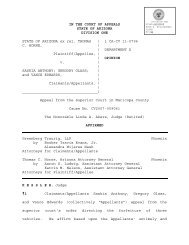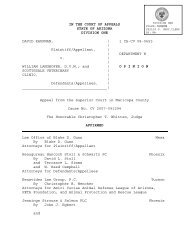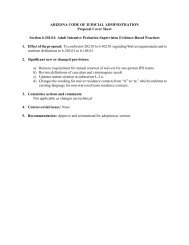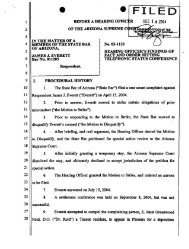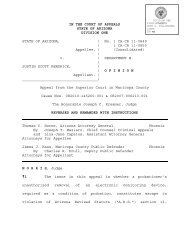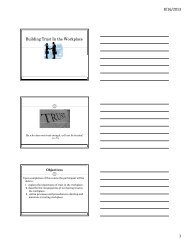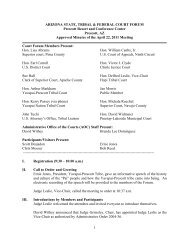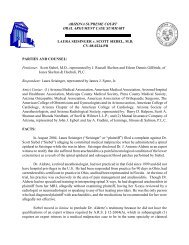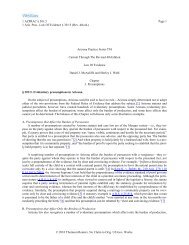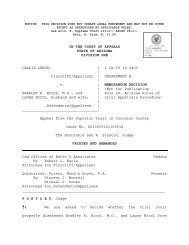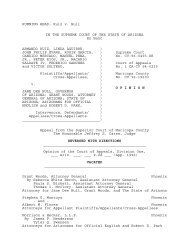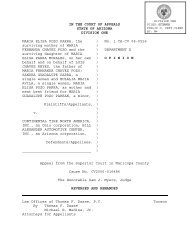1 CA-CV 11-0497 - Arizona Judicial Department
1 CA-CV 11-0497 - Arizona Judicial Department
1 CA-CV 11-0497 - Arizona Judicial Department
Create successful ePaper yourself
Turn your PDF publications into a flip-book with our unique Google optimized e-Paper software.
STEVEN T. WALTNER; SARAH V.<br />
WALTNER,<br />
v.<br />
IN THE COURT OF APPEALS<br />
STATE OF ARIZONA<br />
DIVISION ONE<br />
Plaintiffs/Appellants,<br />
JPMORGAN CHASE BANK, N.A.;<br />
<strong>CA</strong>LIFORNIA RECONVEYANCE COMPANY,<br />
Defendants/Appellees.<br />
)<br />
)<br />
)<br />
)<br />
)<br />
)<br />
)<br />
)<br />
)<br />
)<br />
)<br />
)<br />
1 <strong>CA</strong>-<strong>CV</strong> <strong>11</strong>-<strong>0497</strong><br />
DEPARTMENT C<br />
O P I N I O N<br />
Appeal from the Superior Court in Maricopa County<br />
Cause No. <strong>CV</strong>2010-005986<br />
The Honorable Dean M. Fink, Judge<br />
AFFIRMED<br />
Aiken Schenk Hawkins & Ricciardi, P.C. Phoenix<br />
By André H. Merret<br />
Attorneys for Plaintiffs/Appellants<br />
Maynard Cronin Erickson Curran & Reiter, P.L.C. Phoenix<br />
By Douglas C. Erickson<br />
Attorneys for Defendants/Appellees<br />
H O W E, Judge<br />
1 Steven and Sarah Waltner brought numerous claims<br />
against JPMorgan Chase Bank, N.A., (“Chase”) and California<br />
Reconveyance Company (“CRC”), arising out of Chase’s attempts to<br />
foreclose on two properties the Waltners owned. The Waltners<br />
appeal from the trial court’s decisions (1) denying their
application for entry of default judgment, (2) granting Chase<br />
and CRC’s motion for summary judgment, and (3) denying the<br />
Waltners’ motion for reconsideration of its summary judgment<br />
order.<br />
2 We affirm the trial court’s rulings. We hold that the<br />
trial court properly denied the application for entry of a<br />
default judgment because moving for summary judgment constitutes<br />
“otherwise defend[ing]” under <strong>Arizona</strong> Rule of Civil Procedure<br />
(“Rule”) 55(a), which precludes an entry of default from<br />
becoming effective. We also hold in accordance with Hogan v.<br />
Wash. Mut. Bank, N.A., ___ Ariz. ___, ___, 1, 277 P.3d 781,<br />
782 (2012), that the trial court properly granted summary<br />
judgment because Chase and CRC were not required to prove their<br />
authority or “show the note” before commencing the non-judicial<br />
foreclosure of the Waltners’ property. We further hold that the<br />
trial court did not abuse its discretion in denying the<br />
Waltners’ motion for reconsideration because they did not show<br />
that they exercised due diligence in discovering new evidence or<br />
that the evidence would have likely changed the trial court’s<br />
ruling on the motion for summary judgment.<br />
FACTS AND PROCEDURAL HISTORY<br />
3 In 2005, the Waltners purchased two properties: one<br />
house in Goodyear, and a second house in Avondale that became<br />
their primary residence. Separate loans from Washington Mutual<br />
2
Bank (“WaMu”) financed each purchase, and a deed of trust on<br />
each property secured each loan. Each deed of trust listed CRC<br />
as Trustee. In September 2008, Chase acquired WaMu’s assets<br />
through a Federal Deposit Insurance Corporation (“FDIC”)<br />
receivership. The next month, Chase notified the Waltners that<br />
it had acquired the right to service their loans.<br />
4 In December 2009, CRC sold the Goodyear house at a<br />
trustee’s sale and notified the Waltners that it would sell the<br />
Avondale house in March 2010. On March 9, 2010, the Waltners<br />
filed a thirty-six count complaint against Chase, CRC, and WaMu,<br />
seeking to void the sale of the Goodyear house, enjoin the<br />
scheduled trustee’s sale of the Avondale house, and prevent the<br />
Avondale house’s foreclosure.<br />
5 Chase and CRC moved to dismiss the complaint under<br />
Rule 12(b)(6), arguing that the basis for the Waltners’ claims——<br />
that Chase and CRC had not shown that they held the original<br />
notes and deeds of trusts on the properties——was not legally<br />
supportable. On August 6, 2010, the trial court dismissed all<br />
but five claims against Chase and CRC. 1 The court ruled that<br />
those claims addressed whether Chase and CRC showed that they<br />
were entitled to foreclose under the deeds of trust, and that<br />
1 The court took no action on counts against WaMu, but<br />
subsequently dismissed them without prejudice for lack of<br />
prosecution.<br />
3
while the Waltners’ “‘show me the note’ theory [was] not well<br />
founded,” whether Chase had the right to foreclose could not be<br />
resolved “within the confines” of a motion to dismiss. The court<br />
suggested that these issues might be resolved on a motion for<br />
summary judgment. On August 26, 2010, the Waltners applied for<br />
entry of default against Chase and CRC under Rule 55(a) because<br />
Chase and CRC had not filed an answer to the complaint within<br />
twenty days of the ruling on the motion to dismiss.<br />
6 On September 3, 2010, Chase and CRC moved for summary<br />
judgment, asserting that the complaint’s remaining claims rested<br />
on the incorrect “show me the note” premise. They explained that<br />
Chase had acquired the notes, which were secured by the deeds of<br />
trust, when it acquired WaMu’s assets and liabilities from the<br />
FDIC, and therefore was the beneficiary with the authority to<br />
institute the trustee’s sale. As evidence, Chase and CRC<br />
provided a Chase Litigation Support Analyst’s declaration that<br />
they had acquired the notes.<br />
7 On September 22, the Waltners moved for entry of<br />
default judgment under Rule 55(b). Chase and CRC opposed the<br />
motion, arguing that default could be entered under Rule 55(a)<br />
only if a defendant “failed to plead or otherwise defend” within<br />
ten days of the application, and that they had “otherwise<br />
defended” against the Waltners’ complaint within that time by<br />
moving for summary judgment.<br />
4
8 The Waltners moved to strike (1) the summary judgment<br />
motion because it was untimely and (2) Chase’s declaration<br />
because it was not based on the employee’s personal knowledge,<br />
as Rule 56(e) requires. The court denied the Waltners’ motion to<br />
strike and ordered oral argument and supplemental briefing on<br />
whether (1) filing a motion for summary judgment precluded entry<br />
of default and (2) summary judgment should be granted.<br />
9 After briefing, the court denied the application for<br />
default judgment, finding that even if it entered a default<br />
judgment, that judgment “would likely be lifted.” The court also<br />
granted Chase and CRC summary judgment. The court found that,<br />
despite the Waltners’ attempts to characterize their claims<br />
otherwise, they were asserting a “show me the note” theory,<br />
arguing that a party attempting to foreclose must hold both the<br />
deed of trust and the note. The court noted that federal courts<br />
had found the separation of ownership did not affect the<br />
enforceability of either a note or a deed of trust.<br />
10 The Waltners moved for reconsideration of the court’s<br />
rulings under Rules 59(a) and 60(c) and asserted that newly<br />
discovered evidence supported their claims. They argued that<br />
they had recently discovered that WaMu had sold both of their<br />
loans, first to a WaMu subsidiary and then to a trust three<br />
years before the receivership that ultimately transferred WaMu<br />
5
assets to Chase. The court denied the motion for<br />
reconsideration.<br />
<strong>11</strong> The court entered judgment dismissing the complaint<br />
against Chase and CRC, and the Waltners timely appealed. We have<br />
jurisdiction pursuant to <strong>Arizona</strong> Revised Statutes (“A.R.S.”)<br />
section 12-2101(A)(1) (West 2012). 2<br />
DISCUSSION<br />
1. Denial of Default Judgment<br />
12 The Waltners first argue that the trial court erred in<br />
refusing to enter a default judgment against Chase and CRC. Rule<br />
55(a) allows entry of default when the defending party to an<br />
action “fail[s] to plead or otherwise defend as provided by<br />
these Rules.” The Waltners argue that Chase and CRC’s summary<br />
judgment motion did not constitute “plead[ing] or otherwise<br />
defend[ing]” to preclude the entry of default from becoming<br />
effective under Rule 55(a). Whether a summary judgment motion<br />
precludes the entry of default from becoming effective under the<br />
<strong>Arizona</strong> Rules of Civil Procedure is a question of law that we<br />
review de novo. See Hornbeck v. Lusk, 217 Ariz. 581, 582, 4,<br />
177 P.3d 323, 324 (App. 2008) (“[w]hen the resolution of an<br />
issue depends on the interpretation and interplay of court rules<br />
and statutes, we review the superior court’s ruling de novo.”).<br />
2 We cite the current version of applicable statutes when no<br />
revisions material to this decision have occurred.<br />
6
13 We hold that timely moving for summary judgment<br />
constitutes “plead[ing] or otherwise defend[ing]” under Rule<br />
55(a). Of course, a motion for summary judgment is not a<br />
“pleading” under the <strong>Arizona</strong> Rules of Civil Procedure. See Ariz.<br />
R. Civ. P. 7(a) (listing the permissible pleadings as a<br />
complaint, an answer, a counterclaim, a cross-claim, a third-<br />
party complaint, a third-party answer, and a reply); Graham v.<br />
Goodyear Aerospace Corp., 120 Ariz. 275, 277, 585 P.2d 884, 886<br />
(App. 1978) (Rule 7(a) “sets forth the pleadings allowed under<br />
our civil rules, and neither a motion to dismiss nor a motion<br />
for summary judgment is listed therein.”) (footnote omitted).<br />
14 But moving for summary judgment does qualify as<br />
“otherwise defend[ing]” against the action. “‘Defend’ means to<br />
contest and endeavor to defeat a claim or demand made against<br />
one in a court of justice.” Davis v. Superior Court (Hannah),<br />
25 Ariz. App. 402, 403, 544 P.2d 226, 227 (1976); see also<br />
Rashidi v. Albright, 818 F. Supp. 1354, 1355–56 (D. Nev. 1993)<br />
(”Failure to ‘otherwise defend’ presumes the absence of some<br />
affirmative action on the part of a defendant [that] would<br />
operate as bar to the satisfaction of the moving party’s<br />
claim.”). A defendant in a cause of action who moves for summary<br />
judgment contests a plaintiff’s claim and argues that it<br />
presents “no genuine issue as to any material fact and that the<br />
moving party is entitled to a judgment as a matter of law.”<br />
7
Ariz. R. Civ. P. 56(c). A summary judgment in a defendant’s<br />
favor bars satisfaction of the plaintiff’s claim and necessarily<br />
defeats it.<br />
15 Other jurisdictions that have considered this issue<br />
agree that moving for summary judgment qualifies as “otherwise<br />
defend[ing]” for purposes of Rule 55(a) and precludes the entry<br />
of default from becoming effective. See Rashidi, 818 F. Supp. at<br />
1356 (“[A] summary judgment motion [that] speaks to the merits<br />
of the case and demonstrates a concerted effort and an<br />
undeniable desire to contest the action is sufficient to fall<br />
within the ambit of ‘otherwise defend’ for purposes of Fed. R.<br />
Civ. P. 55.”); Lexington Fayette Cnty. Food and Bev. Ass’n v.<br />
Lexington-Fayette Urban Cnty. Gov’t, 131 S.W.3d 745, 756–57 (Ky.<br />
2004) (finding that the defendant “otherwise defended” the<br />
action whether its motion “was considered a motion to dismiss or<br />
a motion for summary judgment”); Klock v. Town of Cascade,<br />
943 P.2d 1262, 1266 (Mont. 1997) (holding that a motion for<br />
summary judgment constitutes “otherwise defend[ing]” under Rule<br />
55); Equable Ascent Fin. v. Christian, 962 N.E.2d 322, 324 (Ohio<br />
App. 20<strong>11</strong>) (holding that a motion to dismiss or for summary<br />
judgment precluded default judgment); M & A Const. Corp. v. Akzo<br />
Nobel Coatings, Inc., 936 P.2d 451, 455 (Wyo. 1997) (“Akzo had<br />
otherwise defended the case by filing its motion for summary<br />
judgment . . . .”); see also Cimarron Mortg. Co. v. Wright,<br />
8
831 So. 2d 18, 21 (Ala. 2002) (Johnstone, J., concurring<br />
specially) (“While Cimarron refused to plead with a<br />
counterclaim, it did ‘otherwise defend as provided by these<br />
rules’ by filing the motion for summary judgment . . . .”)<br />
(emphasis omitted); Grenier v. Comm’r, 51 A.3d 367, 377 n.10<br />
(Conn. 2012) (motion for summary judgment may be used to test a<br />
pleading’s legal sufficiency); Coral Ridge Props. v. Playa Del<br />
Mar Ass’n, 505 So. 2d 414, 417 (Fla. 1987) (finding a responsive<br />
pleading unnecessary when summary judgment disposes of suit);<br />
Chicago Cent. & Pac. R. Co. v. Calhoun Cnty., 816 N.W.2d 367,<br />
373 n.2 (Iowa 2012) (defending parties may raise defenses in<br />
pre-answer motion for summary judgment). 3 The near-unanimity of<br />
the interpretation of “otherwise defends” in these jurisdictions<br />
gives added force to our own conclusion.<br />
16 The Waltners’ argument to the contrary——that filing a<br />
motion for summary judgment cannot prevent default because the<br />
motion does not toll the time for filing an answer required by<br />
Rule 12(a)(3)(A)——is not well taken for two reasons. First, Rule<br />
3 Contrary to the weight of authority, the Missouri Court of<br />
Appeals——in interpreting Missouri’s rule of civil procedure<br />
addressing default judgments——has declined to “expand the phrase<br />
‘or otherwise defend as provided by these rules’ to include the<br />
filing of answers to discovery or the filing of a summary<br />
judgment motion.” J.E. Scheidegger Co. v. Manon, 149 S.W.3d 499,<br />
503 (Mo. App. 2004). The court has nevertheless recognized that<br />
the filing of a summary judgment motion is “important” in<br />
determining whether to set aside the default judgment. Id.<br />
9
55(a) governs the entry of default, not Rule 12; and as we have<br />
now held, filing a motion for summary judgment constitutes<br />
otherwise defending, which precludes an entry of default from<br />
becoming effective.<br />
17 Second, even if Rule 12(a)(3)(A) were relevant to this<br />
issue, the time for filing an answer is indeed tolled pending<br />
the resolution of a motion for summary judgment. Rule 12(b)(6)<br />
allows a defending party to file a motion to dismiss because the<br />
complaint fails to state a claim upon which relief can be<br />
granted, and requires that the motion be filed before filing a<br />
responsive pleading. If the motion to dismiss presents matters<br />
outside the pleadings and the court considers them in its<br />
ruling, the court must treat it as a motion for summary<br />
judgment. Ariz. R. Civ. P. 12(b). The filing of such a motion<br />
tolls the time for filing the responsive pleading——the answer——<br />
until ten days after the court rules on the motion. Id. at<br />
12(a)(3)(A).<br />
18 Because a motion to dismiss treated as a summary<br />
judgment motion tolls the time for filing an answer, a motion<br />
for summary judgment filed in the first instance logically also<br />
tolls the time for filing an answer. Federal courts interpreting<br />
Federal Rule of Civil Procedure 12(b)(6) have so held. INVST<br />
Fin. Grp. v. Chem-Nuclear Sys., Inc., 815 F.2d 391, 403 (6th<br />
Cir. 1987) (“Courts and commentators have acknowledged that no<br />
10
answer need be filed before a defendant’s motion for summary<br />
judgment may be entertained.”); Hubicki v. ACF Indus., Inc.,<br />
484 F.2d 519, 522 (3d Cir. 1973) (stating that a motion for<br />
summary judgment “may be made before pleading to the<br />
complaint”); Rashidi, 818 F. Supp. at 1356 (“Although Rule 12<br />
does not specifically allow for a summary judgment motion to<br />
toll the running of the period within which a responsive<br />
pleading must be filed, by analogy the language would seem to<br />
apply . . . .”); see also 10A Wright, Miller, Kane & Marcus,<br />
Federal Practice & Procedure § 2718 (3d ed. 2012) (“There seems<br />
to be no compelling reason for treating a motion originally made<br />
under Rule 56 differently from one that has been transformed<br />
into a summary judgment motion. Therefore, a summary judgment<br />
motion made prior to an answer should have the benefit of the<br />
Rule 12(a) language tolling the period of time in which an<br />
answer must be filed.”). Federal cases interpreting federal<br />
rules of civil procedure that are similar to our rules are<br />
instructive and persuasive in construing our rules, and we<br />
“subscribe to the principle that uniformity in interpretation of<br />
our rules and the federal rules is highly desirable.” Orme Sch.<br />
v. Reeves, 166 Ariz. 301, 304, 802 P.2d 1000, 1003 (1990).<br />
19 Under these principles, entry of a default judgment<br />
against Chase and CRC would have been inappropriate. The<br />
Waltners applied for a default judgment on their five remaining<br />
<strong>11</strong>
claims on August 26, 2010. Less than ten days later——on<br />
September 3, 2010——Chase and CRC defended those claims by moving<br />
for summary judgment. That satisfied the requirements of Rule<br />
55(a)(3) to prevent the entry of default from becoming<br />
effective, and the trial court did not err in denying the<br />
Waltners’ application for entry of default judgment. 4<br />
2. Granting Chase and CRC’s Motion for Summary Judgment<br />
20 The Waltners argue that the trial court erroneously<br />
granted Chase and CRC summary judgment, asserting that a genuine<br />
issue of material fact remains about whether Chase actually<br />
acquired the Waltner notes and became the beneficiary with the<br />
authority to enforce the deed of trust. We review de novo the<br />
grant of summary judgment and affirm if, viewing the facts in<br />
the light most favorable to the party against whom judgment was<br />
entered, no genuine issue of material fact exists and the moving<br />
party is entitled to judgment as a matter of law. Ariz R. Civ.<br />
P. 56(c); Wang Elec., Inc. v. Smoke Tree Resort, LLC, 230 Ariz.<br />
314, 318, 9, 283 P.3d 45, 49 (App. 2012).<br />
4 Because we hold that filing the motion for summary judgment<br />
precluded entry of default, we need not address the trial<br />
court’s ruling that a default judgment, if entered, would have<br />
likely been set aside. See Powers v. Guar. RV, Inc., 229 Ariz.<br />
555, 560, 13, 278 P.3d 333, 338 (App. 2012) (Stating that an<br />
appellate court will affirm the trial court’s ruling if the<br />
court “reached the right result for the wrong reason.”)<br />
(internal quotation marks and citation omitted).<br />
12
21 No genuine issue of material fact exists about whether<br />
Chase and CRC had the authority to enforce the deed of trust.<br />
The <strong>Arizona</strong> Supreme Court recently held that “<strong>Arizona</strong>’s non-<br />
judicial foreclosure statutes do not require the beneficiary to<br />
prove its authority or ‘show the note’ before the trustee may<br />
commence a non-judicial foreclosure.” Hogan, ___ Ariz. at ___,<br />
1, 277 P.3d at 782. In Hogan, the plaintiff sued to enjoin<br />
trustees’ sales unless the beneficiaries proved that they were<br />
entitled to collect on the respective notes. Id. at 3. The<br />
court recognized that a deed of trust could be enforced only by<br />
one having the right to enforce the underlying obligation, but<br />
rejected the argument that the enforcing party had the burden of<br />
demonstrating its rights before a non-judicial foreclosure sale<br />
could occur. Id. at ___, 6, 277 P.3d at 783. The court noted<br />
that non-judicial foreclosures were intended to be quick,<br />
efficient, and outside of the judicial process, and that<br />
[r]equiring the beneficiary to prove<br />
ownership of a note to defaulting trustors<br />
before instituting non-judicial foreclosure<br />
proceedings might again make the mortgage<br />
foreclosure process . . . time-consuming and<br />
expensive, and re-inject litigation, with<br />
its attendant cost and delay, into the<br />
process.<br />
Id. at ___, 12, 277 P.3d at 784 (internal quotation marks and<br />
citations omitted).<br />
13
22 The Waltners’ claims that survived the motion to<br />
dismiss depend on their contention that Chase was not the<br />
beneficiary under the deeds of trust, which was based on the<br />
assertion that Chase had not established that it acquired the<br />
underlying notes. Under Hogan, Chase was not required to prove<br />
it held the underlying notes before proceeding with the non-<br />
judicial foreclosures.<br />
23 Nevertheless, the record contains evidence that Chase<br />
acquired all the interest in the Waltner loans that WaMu<br />
previously held. The Waltners alleged in their complaint that<br />
they had received two loans from WaMu secured by two deeds of<br />
trust. As part of their motion to dismiss, Chase and CRC<br />
submitted to the court the Purchase and Assumption Agreement<br />
between the FDIC, the FDIC as WaMu’s Receiver, and Chase. Under<br />
that agreement, Chase assumed all of WaMu’s mortgage servicing<br />
rights and obligations. Chase and CRC also provided an affidavit<br />
from WaMu’s FDIC Receiver that Chase had acquired all of WaMu’s<br />
loans and loan commitments under the Purchase and Assumption<br />
Agreement as of September 25, 2008. Letters from Chase notified<br />
the Waltners that Chase had acquired their WaMu loans——<br />
identified by loan number——through the FDIC. Chase also provided<br />
a declaration of a Chase Litigation Support Analyst that it had<br />
acquired the promissory notes secured by deeds of trust on the<br />
Waltners’ two properties and therefore had become the<br />
14
eneficiary under both deeds of trust. 5 The Waltners produced<br />
nothing to refute this evidence. Based on this record, the trial<br />
court did not err in granting Chase and CRC summary judgment.<br />
3. Denial of the Motion for Reconsideration<br />
24 The Waltners argue that the trial court abused its<br />
discretion in denying their motion for reconsideration pursuant<br />
to Rule 59(a) on the grounds of newly discovered evidence. 6 To<br />
obtain relief, the moving party must demonstrate that the<br />
evidence (1) is material, (2) existed at the time of trial,<br />
(3) could not have been discovered before trial by the exercise<br />
of due diligence, and (4) would probably change the result at a<br />
new trial. Wendling, 143 Ariz. at 602, 694 P.2d at 1216. We<br />
affirm a trial court’s decision on a motion for new trial absent<br />
a showing of a clear abuse of discretion. Id.<br />
5 The Waltners argue that the trial court could not have relied<br />
on the Chase Litigation Support Analyst’s affidavit because he<br />
had no personal knowledge of Chase’s acquisition of the Waltner<br />
notes, and that the court therefore erred in granting summary<br />
judgment. While the Waltners are correct that an affidavit must<br />
be based on the affiant’s personal knowledge, Ariz. R. Civ. P.<br />
56(e), we need not consider this argument because even without<br />
consideration of the affidavit, the record contains evidence<br />
establishing that Chase had acquired all rights to the Waltners’<br />
loans that WaMu previously held.<br />
6 The Waltners moved for reconsideration under both Rule 59(a)<br />
and Rule 60(c). Because they filed their motion within the time<br />
frame of Rule 59(d), we review it as a motion for new trial<br />
under Rule 59(a)(4). Wendling v. Sw. Sav. & Loan Ass’n,<br />
143 Ariz. 599, 601 n.2, 694 P.2d 1213, 1215 n.2 (App. 1984).<br />
15
25 In the motion for reconsideration and the attached<br />
declaration of Sarah Waltner, the Waltners contended that they<br />
had discovered through internet research, telephone calls and<br />
emails to various entities, an Offering Circular related to a<br />
trust. From this information, they deduced that their loans were<br />
“likely” in a class of loans that were sold to a trust called<br />
“WaMu Mortgage Pass-Through Certificates, Series 2005-PR4” in<br />
December 2005, years before Chase acquired the loans of WaMu. We<br />
find no abuse of discretion in the trial court’s decision to<br />
deny the motion. Even assuming the proffered information was<br />
admissible evidence, it would not likely change the result. The<br />
Waltners’ contended that the loans were sold to a trust whose<br />
name indicated a connection to WaMu. Chase acquired all of<br />
WaMu’s loans under the Purchase and Assumption Agreement.<br />
Nothing in the Waltners’ motion or declaration demonstrates that<br />
the loans were sold and not part of the transaction with Chase.<br />
26 In addition, the Waltners did not demonstrate that<br />
this information could not have been discovered by due diligence<br />
before the court’s ruling. The declaration regarding the<br />
discovery of this information stated that Sarah Waltner had met<br />
with resistance when requesting information, but also stated<br />
that the events leading to her “discoveries” began with the<br />
Waltners serving subpoenas on Chase and Wells Fargo Bank on<br />
February 10, 20<strong>11</strong>. The Waltners had filed this lawsuit in March<br />
16
2010, nearly a year earlier, and had filed their reply to Chase<br />
and CRC’s motion for summary judgment four months earlier. The<br />
Waltners offered no explanation for waiting so long before<br />
pursuing this line of investigation. The court therefore did not<br />
abuse its discretion in denying the motion for new trial.<br />
CONCLUSION<br />
27 We find that Chase and CRC’s motion for summary<br />
judgment satisfied Rule 55(a)’s requirement that a party “plead<br />
or otherwise defend,” precluding the entry of default. We<br />
further find that the trial court did not err in granting Chase<br />
and CRC summary judgment or in denying the Waltner’s motion for<br />
reconsideration. The trial court’s ruling is affirmed.<br />
CONCURRING:<br />
/s/<br />
RANDALL M. HOWE, Judge<br />
/s/<br />
MARGARET H. DOWNIE, Acting Presiding Judge<br />
/s/<br />
PATRICIA A. OROZCO, Judge<br />
17




